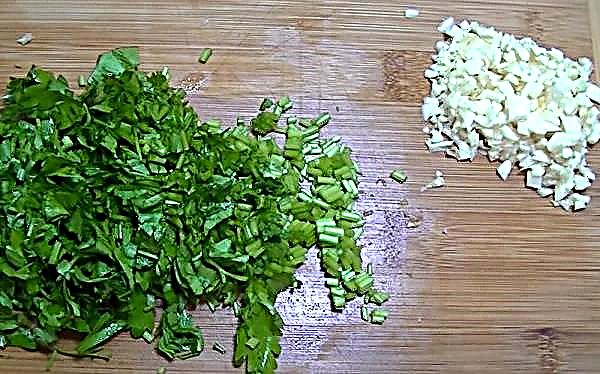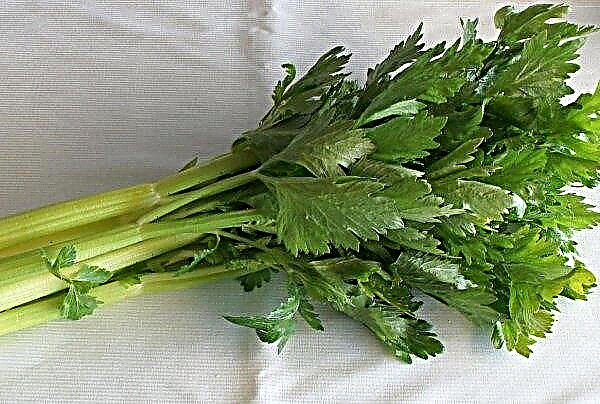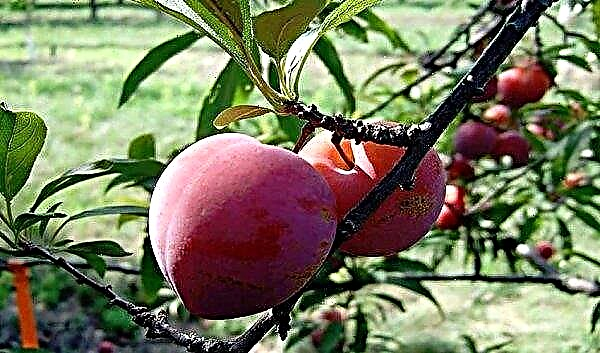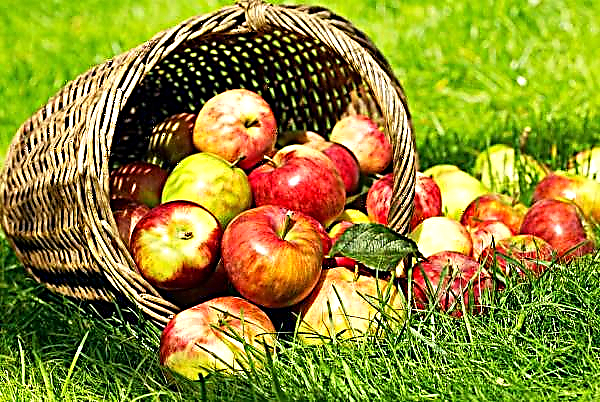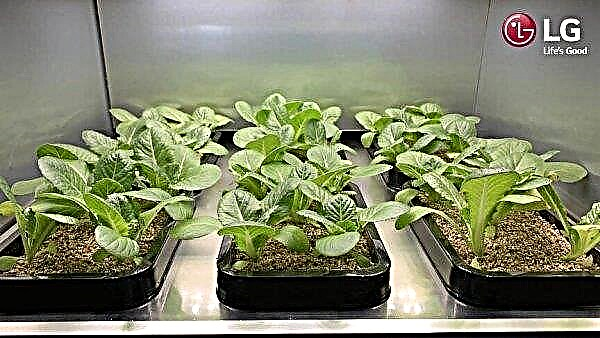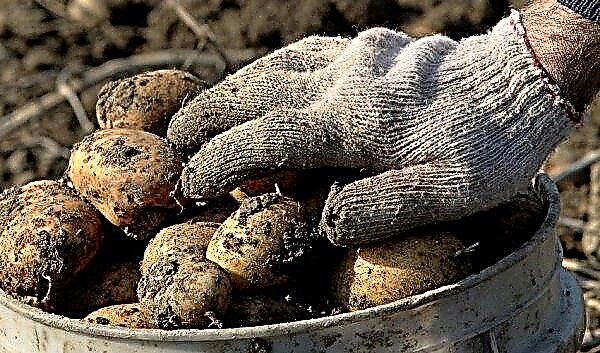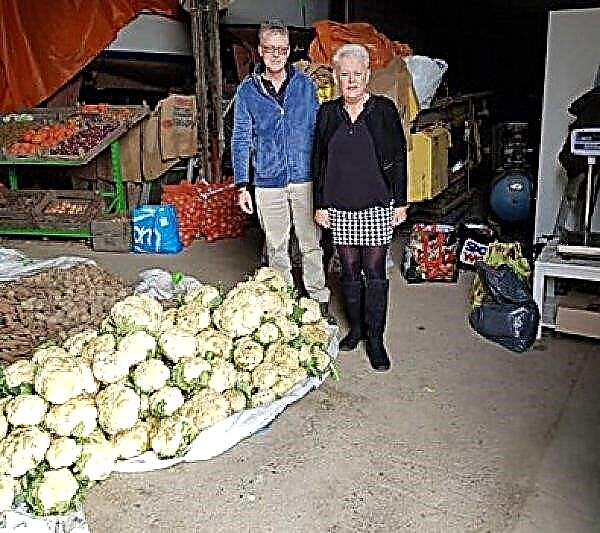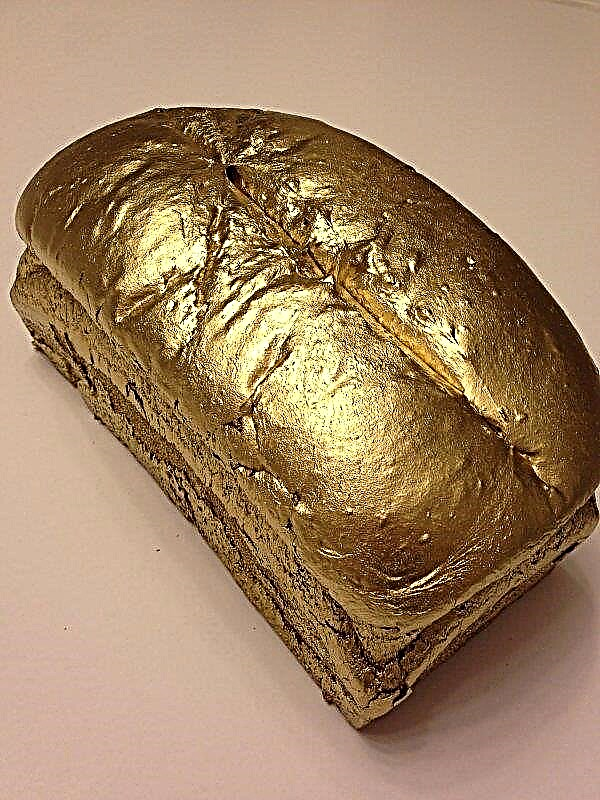The cultivation of wheat in the technological process differs significantly from the cultivation of garden and garden plants. In particular, this applies to the requirements of this grain crop for the composition of the soil. About what mineral elements and organic fertilizing is needed for wheat during the growing season, what are the features of their application for winter and spring plantings, as well as about many other subtleties of applying fertilizers on wheat fields - further in all details.
When to Feed Wheat
The vegetation period of any grain crop, including wheat, is conventionally divided into three main stages:
- seed germination and the emergence of young shoots;
- exit to the tube (this term refers to the stage of active growth of the aerial part of the ear);
- formation, pouring and final ripening of grain.

An important condition for the proper development of the plant at each of the mentioned stages is a balanced diet, but its composition changes significantly with the growth and maturation of the ear.
In addition, the phases of development of wheat planted in autumn and spring do not coincide in calendar terms, therefore, different fertilizer application schedules are used for winter and spring plantings.
Important! Winter and spring wheat have different ripening periods. So, with the winter method of growing, the full cycle of the growing season of the crop is from 190 to 280 days, while when sowing the crop in the spring it is only 90-120 days.
Wheat Nutrients
A good grain yield is ensured by the integrated action of the following minerals:
- nitrogen;
- potassium;
- phosphorus;
- calcium;
- sulfur;
- magnesium.
In addition, wheat needs a number of trace elements, in particular copper, manganese, iron, zinc, molybdenum and chlorine. They are responsible for the correct course of cellular processes in the ear and ultimately create the necessary conditions for its maturation.
 Depending on the method of cultivation, the need for culture in these components, and, therefore, the quantity and system for supplying each type of mineral fertilizer to the soil, has its own specifics.
Depending on the method of cultivation, the need for culture in these components, and, therefore, the quantity and system for supplying each type of mineral fertilizer to the soil, has its own specifics.
For winter
A feature of winter wheat is the prolonged period of the vegetation cycle, and the formation of the root system can occur at fairly low temperatures. If at this moment the soil does not have the right amount of nutrients, the structure of the spike cannot be formed, and you can forget about a good crop.
Important! Winter wheat consumes nutrients less intensively than spring wheat, but it makes higher demands on the acid-base balance and the general indicator of soil fertility.
The growing season of winter wheat is associated with increased consumption of minerals such as nitrogen, phosphorus and potassium.
So, a ton of grain grown on fertile soil impoverishes its composition in basic nutrients on average by such an amount:
- nitrogen - loss of 30–35 kg;
- phosphorus - loss of 10–13 kg;
- potassium - a loss of 20-30 kg.
And if we take into account that part of the nutrients, as the ear ripens, passes from the root system of the plant to the above-ground, then the consumption of the corresponding group of minerals is actually even higher.

The culture absorbs the main part of nitrogen and phosphorus at the stage of exit into the tube, and, to be more precise, then, depending on climatic conditions and the dosage of fertilizer in the ground, either during tillering and milk ripeness, or at the flowering stage.
On average, the need for winter wheat in nitrogen-phosphorus-potassium components as the plant develops looks like this:
| Battery | Consumption phase |
| Nitrogen | At all stages |
| Phosphorus | The initial stage of rooting, the formation of the root system, the accumulation in the cells of the aerial parts up to and including the exit to the tube, but especially at the tillering stage |
| Potassium | Germination, formation, flowering |
If we take the total dose of minerals consumed by winter wheat per unit, then during the main stages of plant vegetation, the absorption of fertilizers occurs in the following proportions:
- germination and seedling formation - from 0.3 to 0.4 of the required amount;
- exit to the tube - half of the total volume;
- grain ripening - the remainder (approximately 0.2 of the total norm).
For spring
Spring wheat is characterized by a more powerful root system, and therefore its exactitude for soil is not so significant. In this case, we are not talking about the total amount of mineral fertilizers that should be in the ground, but rather about the quality of field preparation. For example, such a thing as denitrification, i.e., nitrogen loss due to poor aeration, threatens spring plantings of wheat slightly less than winter crops.
 If only neutral or slightly acidic soils are suitable for winter varieties, spring soils can grow on the ground with any reaction, except for strongly acidified soil.
If only neutral or slightly acidic soils are suitable for winter varieties, spring soils can grow on the ground with any reaction, except for strongly acidified soil.
Another feature of the spring method of growing wheat is that, in this case, in addition to root dressing, spraying is also widely used. Only such a method can be productive for fertilizing in adverse weather conditions, for example, during a period of severe drought or sudden cooling.
Did you know? Wheat is usually associated with bread, but from the grains of this cereal they produce no less popular, although controversial, from the point of view of its usefulness, product, namely: malt. Specially soaked and sprouted seeds are the main raw material for the manufacture of the three most popular alcoholic beverages in the world - beer, vodka and whiskey.
What tools are needed for fertilizing
The following agricultural equipment is used to feed the wheat fields:
- rotary sprinkler;
- grain fertilizer seeders;
- machine for subsoil spreading of granular fertilizers and seeds;
- machine for intra-soil application of liquid mineral fertilizers.
The modern method of cultivating crops over large areas involves continuous monitoring of the state of crops using satellite monitoring. This system allows you to notice possible problems with the vegetation in time and timely align the emerging negative dynamics.
 Together with the traditional methods of observing the field (periodic visits by agronomists, selective inspection of plants, photofixation, etc.), this approach provides maximum informational content at a relatively low cost.
Together with the traditional methods of observing the field (periodic visits by agronomists, selective inspection of plants, photofixation, etc.), this approach provides maximum informational content at a relatively low cost.
Types of fertilizers
The generally accepted classification of fertilizers involves dividing them into two large groups - mineral and organic. Mineral fertilizer, in turn, can be simple or complex. In the first case, it is intended to enrich the soil with one specific macro- or microelement, in the second - it is a complex of several minerals.
So, A classic example of complex (or, as they are often called, complex) fertilizers are:
- ammophos (ammonium phosphate) - nitrogen + phosphorus;
- diammophos (ammonium hydrogen phosphate) - nitrogen + phosphorus;
- diammofoska (DAFK) - nitrogen + phosphorus + potassium;
- ammofoska (ROS) - nitrogen + phosphorus + potassium;
- azofoska (nitroammofoska) - nitrogen + phosphorus + potassium.
Complex fertilizers containing all three basic macroelements necessary for the development of most plants are usually denoted by the abbreviation NPK, which consists, respectively, of three generally accepted symbols of these chemical elements (N - nitrogen, P - phosphorus and K - potassium).
Nitrogen
Nitrogen plays an important role in the formation of the aerial part of the plant and the active collection of green mass. If we talk about wheat, then this element is also necessary for it to produce protein, which is part of the cell.
Nitrogen fertilizers include nitrates and ammonium. The advantage of the second group is that, being positively charged, these compounds are better retained in the soil and are not washed out of it by sediments. On the other hand, more mobile nitrates more easily reach the root system and are already converted in it sequentially into ammonium, ammonium acid and then into protein.

Among the most famous varieties of fertilizers of the nitrogen group are:
- carbamide (urea);
- ammonium nitrate;
- lime-ammonium nitrate;
- sodium nitrate;
- potassium nitrate;
- calcium nitrate;
- ammonium sulfide;
- ammonium sulfate;
- calcium cyanamide;
- anhydrous ammonia;
- ammonia water;
- ammonium chloride, etc.
Complex fertilizers ammophos and diammophos, despite the fact that, in addition to the element under consideration, also includes phosphorus, according to some classifications, they are also classified as nitrogen.
Important! Wheat needs nitrogen higher than any other nutrient. With a lack of nitrogen, the plant turns pale, then turns yellow, after which the lower leaves of the ear die off completely, while the upper ones become smaller.
Potash
- Potassium performs several important functions in the development of a plant:
- provides a balanced charge of the inner and outer parts of the cell (electrochemical balance);
- moves photosynthesis products between different parts of the ear;
- activates some enzymatic processes;
- preserves turgor pressure - the stress state of the cell membrane
Potassium deficiency is manifested in a weakening of the stem of the cereal and a slowdown in its growth. As with the lack of nitrogen, lack of potassium leads to yellowing and drying out of the shoot, but this time the problems begin not from the lower, but, on the contrary, from the upper leaves and move to the base of the spike. In general, the potassium deficiency in the wheat field is very similar in appearance to the effects of drought.
The problem of saturation of the root system of plants with potassium is that this element is characterized by low mobility and therefore is difficult to digestIn addition, in order to reach positively charged ions, wheat needs to develop a fairly powerful root system.

That is why under adverse weather conditions, for example, low temperatures, high humidity and other factors that impede the development of roots or cause their diseases, even a sufficient amount of potassium in the soil does not solve the problem of proper saturation of crops with this important element for their growth.
Potash fertilizers used to feed crops include drugs such as:
- potassium salt;
- potassium nitrate;
- potassium carbonate (potassium carbonate);
- potassium sulfate (potassium sulfate);
- potassium magnesium sulfate (kalimagnesia);
- potassium chloride (potassium chloride).
In addition, complex fertilizers are also used as a source of potassium, including ammofosk, diammofosk, azofosk, etc.
Did you know? Wood ash is a widely used fertilizer having a very complex chemical composition in which potassium, magnesium, calcium, sulfur, chlorine, sodium, phosphorus and other elements are present. However, from this entire list, it is potassium that is in the form most assimilated for plants, and cereals are champions in its consumption from ash.
Phosphoric
Phosphorus is a key element in many intracellular processes in plant tissues.. Along with nitrogen, potassium, oxygen, carbon and hydrogen, it enters the chemical formula of the cell membrane, many molecules, including deoxyribonucleic acid, provides energy metabolism and mutual integration of plant cells.
It is significant that even with a high content of the phosphorus component in the soil, wheat crops are grateful for the additional fertilizing of this group, since they are the ones allow the root system of the cereal to combat numerous pathogenic soil pests that affect crops, especially in case of violation of crop rotation rules and long-term planting of grain on the same area.
 The lack of this mineral leads to a significant weakening of the culture, delaying its growth, thinning the stem, reducing the size and color of the leaves, delaying the formation of spikes, and problems with the root system.
The lack of this mineral leads to a significant weakening of the culture, delaying its growth, thinning the stem, reducing the size and color of the leaves, delaying the formation of spikes, and problems with the root system.
The main type of phosphate fertilizer is superphosphate - single or double. But more often this element is still used as part of various complex preparations, which, in addition to the above, also include:
- potassium metaphosphate;
- phosphorite flour;
- bone meal, etc.
The availability of phosphorus for wheat roots and the optimal choice of a suitable fertilizing composition directly depend on the acid-base balance of the soil. So, in a neutral and slightly alkaline soil, potassium and iron phosphates are absorbed best, while poorly soluble salts formed by phosphorus with calcium in alkaline soil and with aluminum or iron in acidic soil are almost unattainable for wheat.
The application of phosphorus fertilizers directly during sowing or directly in front of it helps to solve this problem, and it is necessary in combination with nitrogen fertilizers in the form of ammonia. In this case, the delicate cereal sprouts do not come into direct contact with phosphoric acid, and the element manages to transform into forms that are safer for planting.
Important! A characteristic sign of phosphorus deficiency is the acquisition of red wheat leaves.
Calcium
The next mineral necessary for the normal development of wheat is calcium.. He is responsible for the formation of thin root processes, is part of the cell membrane and is the main material of which the connective tissue consists. In addition, it is calcium that provides fixation and transportation between different parts of the plant of other nutrients, for example, potassium.
 The rate of calcium intake of wheat is from 3 to 4 kg per ton of grain.
The rate of calcium intake of wheat is from 3 to 4 kg per ton of grain.
With a calcium deficiency in a plant, the root system first suffers, and then, as a result, the tillering process decreases. Especially often this problem occurs on soils with high acidity and is most pronounced in young shoots. But when such an agrotechnical technique is used in wheat fields as deoxidation of the soil by adding lime to it, in addition to improving the overall soil structure, the availability of calcium also increases for wheat, including due to some neutralization of the excess of manganese, iron and aluminum.
Among the drugs that can eliminate the lack of calcium in the soil, it is worth mentioning:
- calcium sulfate;
- calcium nitrate;
- ground chalk;
- marl;
- dolomite lime;
- ground limestone;
- burnt lime;
- slaked lime;
- lime tuff;
- peat ash.
In small areas and private household plots, calcium can also be saturated with oven ash or crushed egg shells.
Did you know? The ancient Egyptians revered wheat as a national wealth. The images of the process of threshing ears with the help of bull hooves have survived to this day.
Sulfur
Along with nitrogen, sulfur plays an important role in the process of cell growth and regeneration and is an integral part of the cellular protein. Wheat reacts to sulfur deficiency in the same way as it does to nitrogen deficiency, however, these symptoms can manifest themselves more clearly.
Wheat consumes most of the sulfur from the soil in the form of sulfates, which are highly soluble in water and therefore easily absorbed by the root system.. However, in case of violation of crop rotation rules, the content of this element in the soil decreases sharply, therefore without additional application of such preparations as ammonium, magnesium, sodium, potassium or manganese sulfates, crop yields can be severely affected.
 For the normal development of cereal crops, 2.5 to 5.5 kg of sulfur per ton of grain is needed.
For the normal development of cereal crops, 2.5 to 5.5 kg of sulfur per ton of grain is needed.
Magnesium
Magnesium is necessary for wheat, first of all, for the formation of chlorophyll, which, as you know, plays a key role in photosynthesis. In addition, this element, along with phosphorus, provides a number of important intracellular processes in plant tissues.
Did you know? In North America, farmers have recorded a number of cases of strange diseases of cattle grazing in the Great Plain area, in close proximity to winter wheat crops. It turned out that in the leaves of cereals eaten by cows, an acute deficiency of magnesium was observed, and this was the reason for the deterioration of the condition of the animals.
Magnesium top dressing includes: magnesium sulfate, magnesium sulfate, magnesium phosphate, carnalite, cainite, as well as magnesite, vermiculite and dolomite flour, which are capable of releasing magnesium when used on soils with high acidity.
 As a rule, a magnesium deficiency in wheat does not appear externally as acute as a deficiency of other essential nutrients. However, at a critically low dose of this element, the root system of the cereal weakens, as a result of which the yield inevitably decreases.
As a rule, a magnesium deficiency in wheat does not appear externally as acute as a deficiency of other essential nutrients. However, at a critically low dose of this element, the root system of the cereal weakens, as a result of which the yield inevitably decreases.
Organic
Organic fertilizers are such top dressings in which the main nutrients are presented in the form of natural compounds, usually various biological residues. This category includes: manure, bird droppings, compost, peat, sawdust, silt, bark, animal feces, straw, green manure, as well as various household and household waste.
The main disadvantage of organic fertilizers is their high cost, which, in turn, is explained by the slower and more complex production process of such material, in comparison with the manufacturing technology of various mineral compositions and chemical compounds.
Important! According to established practice, organic fertilizers for sowing wheat are applied when the humus content in the soil crosses the lower mark of 2%.
That's why on large-scale areas where wheat is grown, the use of organic matter in the vast majority of cases is a luxurythat puts the manufacturing process on the brink of profitability. On the other hand, it is also impossible to get a good crop on poor and depleted soils, and, therefore, the introduction of organic matter becomes objectively necessary.
In order not to bring the field to such a critical state, crop rotation rules should be followed and organic fertilizers applied in the process of growing crops preceding wheat.
Video: Super crop on cereals using organic fertilizer
Organic consumption rates, depending on the type of soil, are:
- for chernozem - from 20 to 25 tons per 1 ha;
- for gray podzolized and sod-podzolic soils - from 30 to 35 tons per 1 ha.
Wet or, on the contrary, overdried sandy soils are best fertilized not with manure, but by planting green manure with the simultaneous application of mineral fertilizers of the phosphorus-potassium group.
Proportions of Batteries
For the normal development of wheat, it is important not only, but possibly not so much the presence of all the necessary nutrients in the soil, as their optimal ratio, because when the permissible proportions are violated, some compounds begin to neutralize the action of others, thus turning from fertilizers to toxins.
Did you know? The oldest bread in the world was discovered during excavations of the ancient Roman city of Pompeii, who died, as you know, under the streams of red-hot lava of Vesuvius. Despite the fact that the loaf is completely petrified, scientists have managed to unravel the mystery of the old recipe, and today in Italy you can try an authentic dish made in strict accordance with ancient canons.
According to generally accepted recommendations, the ideal ratio of nitrogen, phosphorus and potassium for wheat is 3:2:2. At the same time, specific norms for introducing the main macroelements into wheat fields depend on climatic conditions and the method of growing the crop (winter or spring).
In general, the basic indicators of the required dose of nitrogen, phosphorus and potassium, calculated in kilograms per ton of grain, look like this:
| Natural area | Winter way, NPK | Spring mode, NPK |
| Chernozemye | 25,6/9,2/15,7 | 31,3/10,3/19,0 |
| Volga region | 27,7/8,2/17,2 | 30,2/11,2/19,9 |
| Non-chernozem region | 27,3/7,9/23,2 | 29,1/10,6/21,0 |
| North Caucasus | 28,9/9,0/20,8 | 30,8/12,07/25,34 |
| Ural | 28,05/7,97/24,3 | 29,9/10,7/22,0 |
Fertilizer application
As a rule, the method of applying fertilizers for wheat planting involves three stages of feeding:
- at the time of preparing the soil for planting, pre-sowing cultivation or harrowing (in spring or autumn, depending on the method of cultivation);
- tape method at the same time as sowing;
- during the growing season (usually in the phase of going into the tube or earing).
The first of these three stages involves an emphasis on the phosphorus and potassium components of top dressing. It is the subsequent plowing of the soil and the penetration of mineral fertilizers into it that will ensure the maximum digestibility of these two elements.
 Nitrogen is usually applied to the soil with the seed.
Nitrogen is usually applied to the soil with the seed.
The last top dressing is necessary for the proper formation of an ear and, accordingly, ensuring a high quality crop. During this period, complex mineral fertilizer (nitrogen-phosphorus-potash) is usually used, and if the soil is very depleted, the amount of preparation per hectare should be from 30 to 35 kg.
Security measures
Many mineral fertilizers are highly toxic, therefore, when using them, it is important to strictly observe the standard safety rules. These include, in particular, the following measures:
- Minor children, as well as persons who have not undergone a comprehensive medical examination, training course, internship, who have not heard a detailed briefing on labor protection issues and who have not passed the exam prescribed for the relevant type of work, should not be allowed to work.
- The frequency of briefing when working with mineral fertilizers is 1 time in 3 months (standard standards for activities associated with increased risk).
- The type of chemical product used should be well known to its employee, primarily in terms of the toxicity of the substance, its detrimental effect on the body and ways to neutralize this effect.
- It is forbidden to spray fertilizers into the fields of persons under the influence of alcohol, drugs or drugs.
- During work with mineral fertilizers, you should not eat or take off personal protective equipment.
- The tool used in the process of making preparations must be fully operational.
- During operation, the loader should be positioned on the windward side with respect to the drill.
- Blown clogged pipes, faucets, nozzles and other equipment should be carried out exclusively with the help of special pumps, but in no case by mouth.
- It is not allowed to exceed the standards for introducing mineral substances into the soil, as well as non-compliance with the rules regarding the depth of their incorporation.
- Fertilizing the fields is recommended in the morning or evening hours in calm weather.
A high yield of wheat depends on many factors. Not the least role in this list is played by the presence of nutrients in the soil and their optimal balance. But in order to avoid critical errors, the farmer needs not only to memorize standard schedules and norms for applying fertilizers to the fields, but to deeply understand what effect this or that mineral element has on the growth and development of the plant, how its deficiency and excess are manifested, so that , if necessary, make clarifying adjustments to generally accepted doses and methods.

